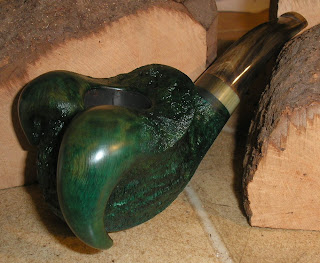
Bowl A is your classic top-down view of a smooth pipe bowl, looking down into the chamber. Light sandblasting, as is done by the majority of blasters, retains this roundness and shape easily, as can be seen in B. It just doesn't take off that much wood, leaving the shape very defined and obvious. This changes when we start doing the sort of very deep, very intense sandblasts that I and others do on our higher grade pipes - One literally begins to sculpt the wood by nature, altering it to nature's inner shape (think of a "skeletal" structure within the wood), as seen below.

Pipe C is a good example of a deep blast and how it changes the bowl. Note that the bowl has actually shrunk from its previous outside diameter - When planning to do a very deep blast, I find I must usually oversize the bowl initially so that the outcome will be closer to what I want. Some people don't like this look - It's a matter of personal preference - but it should be stressed that this IS the natural result of a deep blast. You're literally looking down at the strongest parts of the wood. I make most of my blasts this way because I like and appreciate the natural look. For me, the natural "chaos" of the result is the whole point, in a creative sense - I enjoy starting with a billiard or whatever and seeing what its inner architecture will reveal. However, there are ways to do a deep blast and still provide a more-or-less round shape. One method is to use extremely fine nozzles to allow the blasting to be very precisely targeted in order to retain the overall shape while opening recesses, but this is rare - I know of perhaps three or four pipemakers on the planet who do this sort of work. Another method, more common and simpler, is just to do your deep, high pressure blasting, and then sand across the exterior to bring the shape back to a more precise circle, then lightly blast over the pipe again. You can retain the deeper grooves while providing a full sandblast finish.
This gets much trickier when we move to the stem & shank. One can blast the hell out of the bowl because it has nothing to compare to - nothing it must join to - but the shank must join the stem in lines and visual bulk. Remember, heavy blasting actually makes the wood shrink, so a stem & shank join can quickly look awkward. Probably the most common approach to this is to tape a masking ring around the wood that joins the stem and then blast lightly down the shank, producing a result like A, below.

Picture B is the challenge for all pipemakers - If you carry the same pressure and aggressive blasting from the bowl down the shank, you will end up with this look, which I term "shrivel shank". The shank gets noticeably smaller than the stem. The blast is deep and dramatic and even with the bowl, but the lines of the stem-to-shank join are spoiled. Many collectors are fine with this, and prefer the "all over even" blast depth to a varying blast depth, but it bugs me, personally. I like consistent, smooth lines from stems to shanks. Of course this varies sometimes - If I'm going for a particularly gnarly, battered appearance, I'll often do this purposefully, in order to enhance the overall look of the pipe being really weathered.
I suppose what I'm trying to explain is that all these effects are trade-offs in one form or another. There's no such thing as "perfect", there are just different options.

What I have been doing lately is avoiding the masked-off shank briar ring altogether, and simply fading the blasting intensity down the shank, as shown in C, above. Blast carefully, with an eye towards not hitting anything hard enough to start seriously shrinking the shank. The shank nearer to the bowl can be left a bit thicker and blasted deeper, but I reduce the pressure as the blasting approaches the stem join. This retained that stem/shank line I love so much - one even, connected line top and bottom, rather than a shank with a stark "drop off" where the blasting begins. Matter of personal choice, really.
One other option is to make the whole shank fatter to accommodate a heavy blast to match the bowl, but this doesn't work so well in action. It's hard to get the stem-to-shank join flat, for one, and the higher, harder portions of the wood will remain even after blasting, poking out beyond the stem line I desire.
I hope this helps collectors by providing a bit more of a full picture regarding how and why various sandblasting decisions are made!






















